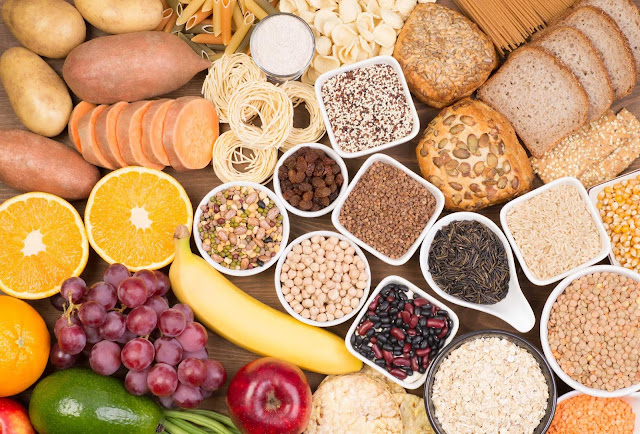Importance of Carbohydrates
Biologically speaking, carbohydrates are molecules that contain carbon, hydrogen and oxygen atoms in specific ratios.
But in the nutrition world, they’re one of the most controversial topics.
Some believe eating fewer carbohydrates is the way to optimal health, while others prefer higher-carb diets. Still, others insist moderation is the way to go.
Types of carbohydrates
The three types of carbs are:
- Sugars. They are also called simple carbohydrates because they are in the most basic form. They can be added to foods, such as the sugar in candy, desserts, processed foods, and regular soda. They also include the kinds of sugar that are found naturally in fruits, vegetables, and milk.
- Starches. They are complex carbohydrates, which are made of lots of simple sugars strung together. Your body needs to break starches down into sugars to use them for energy. Starches include bread, cereal, and pasta. They also include certain vegetables, like potatoes, peas, and corn.
- Fiber. It is also a complex carbohydrate. Your body cannot break down most fibers, so eating foods with fiber can help you feel full and make you less likely to overeat. Diets high in fiber have other health benefits. They may help prevent stomach or intestinal problems, such as constipation. They may also help lower cholesterol and blood sugar. Fiber is found in many foods that come from plants, including fruits, vegetables, nuts, seeds, beans, and whole grains.
Both simple and complex carbohydrates break down into glucose (blood sugar). A simple carb is one that’s comprised of one or two sugar molecules, while a complex carb contains three or more sugar molecules.
Fiber, on the other hand, is found in healthy carbs, but isn’t digested or broken down. It’s been shown to be good for heart health and weight management.
Naturally occurring simple sugars are found in fruit and dairy. There are also processed and refined simple sugars that food companies may add to foods such as sodas, candy, and desserts.
Good sources of complex carbohydrates include:
- whole grains
- legumes
- beans
- lentils
- peas
- potatoes
Fiber is found in many healthy carbs such as:
- fruits
- vegetables
- whole grains
- beans
- legumes
Consuming fibrous, complex and simple carbs from naturally occurring sources like fruit may protect you from disease and may even help you maintain your weight. These carbs include more vitamins and minerals.
However, processed and refined carbohydrates are high in calories but relatively void of nutrition. They tend to make people gain weight and may even contribute to the development of obesity-related conditions, like type 2 diabetes and heart disease.
Daily intake
Carbohydrates should make up 45 to 65 percent of your daily calorie intake according to American dietary guidelines.
For a person eating a standard 2,000 calories a day, this means that carbohydrates might make up 900 to 1,300 of those calories. This figures out to around 225 to 325 grams each day. However, your carb intake will vary based on your individual needs.
Carbs Provide Your Body With Energy
One of the primary functions of carbohydrates is to provide your body with energy.
Most of the carbohydrates in the foods you eat are digested and broken down into glucose before entering the bloodstream.
Glucose in the blood is taken up into your body’s cells and used to produce a fuel molecule called adenosine triphosphate (ATP) through a series of complex processes known as cellular respiration. Cells can then use ATP to power a variety of metabolic tasks.
Most cells in the body can produce ATP from several sources, including dietary carbohydrates and fats. But if you are consuming a diet with a mix of these nutrients, most of your body’s cells will prefer to use carbs as their primary energy source.
Summary: One of the primary functions of carbohydrates is to provide your body with energy. Your cells convert carbohydrates into the fuel molecule ATP through a process called cellular respiration.
They Also Provide Stored Energy
If your body has enough glucose to fulfill its current needs, excess glucose can be stored for later use.
This stored form of glucose is called glycogen and is primarily found in the liver and muscle.
The liver contains approximately 100 grams of glycogen. These stored glucose molecules can be released into the blood to provide energy throughout the body and help maintain normal blood sugar levels between meals.
Unlike liver glycogen, the glycogen in your muscles can only be used by muscle cells. It is vital for use during long periods of high-intensity exercise. Muscle glycogen content varies from person to person, but it’s approximately 500 grams.
In circumstances in which you have all of the glucose your body needs and your glycogen stores are full, your body can convert excess carbohydrates into triglyceride molecules and store them as fat.
Summary: Your body can transform extra carbohydrates into stored energy in the form of glycogen. Several hundred grams can be stored in your liver and muscles.
Carbohydrates Help Preserve Muscle
Glycogen storage is just one of several ways your body makes sure it has enough glucose for all of its functions.
When glucose from carbohydrates is lacking, muscle can also be broken down into amino acids and converted into glucose or other compounds to generate energy.
Obviously, this isn’t an ideal scenario, since muscle cells are crucial for body movement. Severe losses of muscle mass have been associated with poor health and a higher risk of death.
However, this is one way the body provides adequate energy for the brain, which requires some glucose for energy even during periods of prolonged starvation.
Consuming at least some carbohydrates is one way to prevent this starvation-related loss of muscle mass. These carbs will reduce muscle breakdown and provide glucose as energy for the brain.
Summary: During periods of starvation when carbohydrates aren’t available, the body can convert amino acids from muscle into glucose to provide the brain with energy. Consuming at least some carbs can prevent muscle breakdown in this scenario.
Unlike sugars and starches, dietary fiber is not broken down into glucose.
Instead, this type of carbohydrate passes through the body undigested. It can be categorized into two main types of fiber: soluble and insoluble.
Soluble fiber is found in oats, legumes and the inner part of fruits and some vegetables. While passing through the body, it draws in water and forms a gel-like substance. This increases the bulk of your stool and softens it to help make bowel movements easier.
In a review of four controlled studies, soluble fiber was found to improve stool consistency and increase the frequency of bowel movements in those with constipation. Furthermore, it reduced straining and pain associated with bowel movements.
On the other hand, insoluble fiber helps alleviate constipation by adding bulk to your stools and making things move a little quicker through the digestive tract. This type of fiber is found in whole grains and the skins and seeds of fruits and vegetables.
Getting enough insoluble fiber may also protect against digestive tract diseases.
Summary: Fiber is a type of carbohydrate that promotes good digestive health by reducing constipation and lowering the risk of digestive tract diseases.
Certainly, eating excessive amounts of refined carbs is detrimental to your heart and may increase your risk of diabetes.
However, eating plenty of dietary fiber can benefit your heart and blood sugar levels.
As viscous soluble fiber passes through the small intestine, it binds to bile acids and prevents them from being reabsorbed. To make more bile acids, the liver uses cholesterol that would otherwise be in the blood.
Controlled studies show that taking 10.2 grams of a soluble fiber supplement called psyllium daily can lower “bad” LDL cholesterol by 7%.
The risk of heart disease was 9% lower for each additional 7 grams of dietary fiber people consumed per day.
Additionally, fiber does not raise blood sugar like other carbohydrates do. In fact, soluble fiber helps delay the absorption of carbs in your digestive tract. This can lead to lower blood sugar levels following meals.
Although fiber reduced blood sugar levels in people with prediabetes, it was most powerful in people with type 2 diabetes.
Summary: Excess refined carbohydrates can increase the risk of heart disease and diabetes. Fiber is a type of carbohydrate that is associated with reduced “bad” LDL cholesterol levels, a lower risk of heart disease and increased glycemic control.
Are Carbohydrates Necessary for These Functions?
Nearly every cell in your body can generate the fuel molecule ATP from fat. In fact, the body’s largest form of stored energy is not glycogen — it’s triglyceride molecules stored in fat tissue.
Most of the time, the brain uses almost exclusively glucose for fuel. However, during times of prolonged starvation or very low-carb diets, the brain shifts its main fuel source from glucose to ketone bodies, also known simply as ketones.
Ketones are molecules formed from the breakdown of fatty acids. Your body creates them when carbs are not available to provide your body with the energy it needs to function.
Ketosis happens when the body produces large amounts of ketones to use for energy. This condition is not necessarily harmful and is much different from the complication of uncontrolled diabetes known as ketoacidosis.
However, even though ketones are the primary fuel source for the brain during times of starvation, the brain still requires around one-third of its energy to come from glucose via muscle breakdown and other sources within the body.
By using ketones instead of glucose, the brain markedly reduces the amount of muscle that needs to be broken down and converted to glucose for energy. This shift is a vital survival method that allows humans to live without food for several weeks.
Summary: The body has alternative ways to provide energy and preserve muscle during starvation or very low-carb diets.
How are carbohydrates digested?
All the food you eat goes through your digestive system so it can be broken down and used by the body. Carbohydrates take a journey starting with the intake at the mouth and ending with elimination from your colon. There’s a lot that happens between the point of entry and exit.
1. The mouth
You begin to digest carbohydrates the minute the food hits your mouth. The saliva secreted from your salivary glands moistens food as it’s chewed.
Saliva releases an enzyme called amylase, which begins the breakdown process of the sugars in the carbohydrates you’re eating.
2. The stomach
From there, you swallow the food now that it’s chewed into smaller pieces. The carbohydrates travel through your esophagus to your stomach. At this stage, the food is referred to as chyme.
Your stomach makes acid to kill bacteria in the chyme before it makes its next step in the digestion journey.
3. The small intestine, pancreas, and liver
The chyme then goes from the stomach into the first part of the small intestine, called the duodenum. This causes the pancreas to release pancreatic amylase. This enzyme breaks down the chyme into dextrin and maltose.
From there, the wall of the small intestine begins to make lactase, sucrase, and maltase. These enzymes break down the sugars even further into monosaccharides or single sugars.
These sugars are the ones that are finally absorbed into the small intestine. Once they’re absorbed, they’re processed even more by the liver and stored as glycogen. Other glucose is moved through the body by the bloodstream.
The hormone insulin is released from the pancreas and allows the glucose to be used as energy.
4. Colon
Anything that’s left over after these digestive processes goes to the colon. It’s then broken down by intestinal bacteria. Fiber is contained in many carbohydrates and cannot be digested by the body. It reaches the colon and is then eliminated with your stools.





Comments
Post a Comment